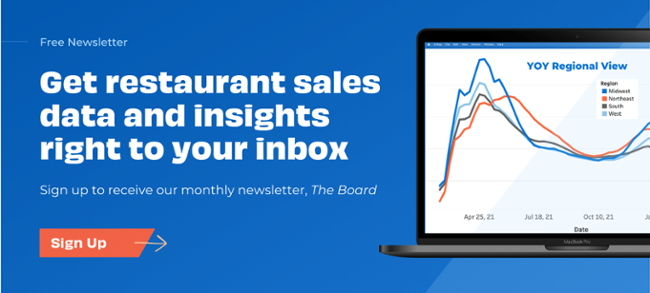Scaling your restaurant business: best practices for managing rapid growth
This post was written by Incentivio, the only fully automated intelligence-driven guest engagement platform for restaurants and virtual kitchens that increases retention, maximizes revenue, and enhances the guest experience for both first-time visitors and loyalists.
As a restaurant owner or operator, you know that running a successful restaurant business is no easy feat. From managing daily operations to keeping up with industry trends, there's always something that requires your attention. But what happens when your restaurant starts to grow rapidly? How do you manage that growth while maintaining the same level of quality and efficiency that your customers have come to expect? We’ve researched and gathered six best practices and key areas that are essential for scaling and managing rapid growth for your restaurant.
[Sign up for our newsletter] Get sales data and restaurant insights straight to your inbox each month
Here are 6 best practices for managing rapid growth:
1) Utilize restaurant management tools
One of the key ways to manage rapid growth in your restaurant is to utilize restaurant management tools. These tools can help streamline operations and increase efficiency, allowing you to handle a higher volume of customers without sacrificing quality. POS systems, for example, can help you process orders more quickly and accurately, while inventory management software can help you track your supplies and reduce waste. Scheduling apps can help you manage staff schedules more efficiently and ensure that you always have enough employees on hand to handle busy periods.
By investing in these tools, you can save time and money, reduce errors, and improve the overall customer experience. So, be sure to explore the range of restaurant management tools available and find the ones that best meet the needs of your business as you continue to grow.
2) Focus on restaurant growth strategies
There are many strategies that you can pursue to expand your restaurant, from opening new locations to partnering with other businesses. For example, expanding your menu can attract new customers and increase revenue, while opening a new location can help you tap into new markets and grow your customer base.
Partnering with other businesses, such as breweries, cafes, or other neighboring restaurants or food suppliers, can boost brand awareness, showcase new menu items, and increase sales. Offering catering services or introducing a loyalty program allows you to attract and retain customers. You should also consider offering online ordering and having a mobile app, which has become increasingly popular in recent years to enhance your digital dining strategy. By exploring these growth strategies and finding the ones that work best for your brand, you can ensure continued growth and success over time.

Image provided by Envato
3) Plan for restaurant expansion
Planning for restaurant expansion is an important aspect of managing rapid growth, but it can be a daunting task. As your restaurant grows, you may need to expand your physical space, hire more staff, or invest in new equipment.
You'll need to have a solid plan in place to make sure you have the resources to support these changes. This could involve developing a detailed business plan that outlines your expansion goals and timelines, as well as securing funding from investors or lenders. Be sure to factor in important considerations such as zoning regulations, building permits, and insurance requirements as you plan for expansion. By taking a strategic and well-planned approach, you can ensure that your restaurant grows sustainably and profitably.
4) Invest in restaurant marketing
Investing in restaurant marketing is a must if you want to attract customers and retain them. With a loyalty program, you can build a loyal customer base that will help increase your guest retention and revenue. A strong brand identity can help you resonate with your target customers as they will associate certain food items, colors, mottos, and more with your restaurant.
Having a comprehensive restaurant marketing strategy that includes social media marketing, email marketing, paid advertising (Google Ads, social media ads, and more), and public relations (announcements on significant changes, events, or partnerships related to your restaurant), can enhance your brand identity to boost awareness and build a loyal customer base.
5) Monitor and manage costs
Closely monitoring and managing your costs will help you see whether your profitability stays on track as you continue to grow your restaurant. You want to ensure that as you continue to grow, you are scaling your restaurant sustainably and profitably. Think about implementing cost-saving measures such as optimizing your menu, negotiating with suppliers for better pricing, and closely tracking inventory and waste.
Keeping your data streamlined and using restaurant management tools that automate back-office operations will help you scale your restaurant!

Image provided by Envato
6) Hire like-minded people
When you hire, look for people who share your vision. Find employees who are passionate about their jobs and see the restaurant as a way of life, not just a job. You should also choose people who have a similar work ethic as yours: if one person is too laid back while another is more aggressive, it can cause problems down the road when working under pressure during busy periods (or even just around guests). After you have hired your staff, it’s important to make sure they know what is expected of them. Make sure every new employee has a clear understanding of their job description and what type of personality fits best in each position!
Managing rapid growth in a restaurant business requires careful planning, strategic decision-making, and a willingness to adapt to changing circumstances. By utilizing restaurant management tools, focusing on growth strategies, planning for expansion, investing in marketing, and monitoring and managing costs, you can ensure that your restaurant grows sustainably and profitably. Whether you're just starting or you're looking to take your existing business to the next level, these best practices can help you achieve your goals and drive long-term success. Remember that managing rapid growth is an ongoing process, and it's important to continually evaluate and adjust your strategies as your business evolves!
About the author
Kamryn Elliott is the Marketing Manager at Incentivio, the only automated and true all-in-one restaurant engagement platform that increases retention and revenue and enhances the digital guest experience. Her first introduction to the restaurant industry was working as a barista. Now, she bridges the gap between technology and restaurants, helping them navigate the complex world of the digital guest journey and customer engagement.


